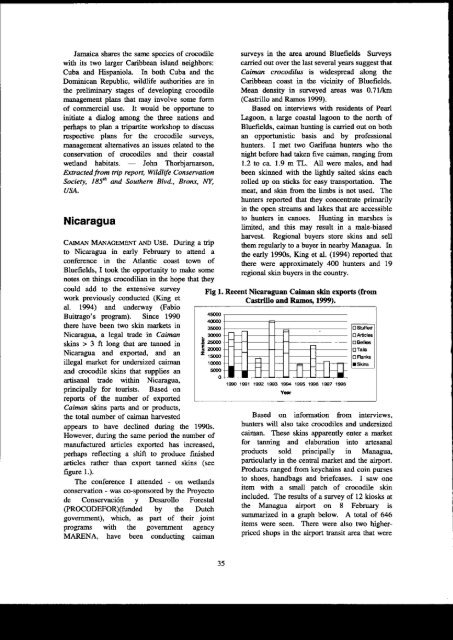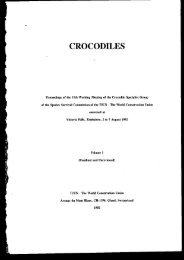NEWSLETTER - Crocodile Specialist Group
NEWSLETTER - Crocodile Specialist Group
NEWSLETTER - Crocodile Specialist Group
Create successful ePaper yourself
Turn your PDF publications into a flip-book with our unique Google optimized e-Paper software.
Jamaica shares the same species of crocodile<br />
with its two larger Caribbean island neighbors:<br />
Cuba and Hispaniola- In both Cuba and tlte<br />
Dominican Republic, wildlife authorities are in<br />
the preliminary stages of developirg crocodile<br />
management plans that may involve some form<br />
of commercial use. It would be opportune to<br />
initiate a dialog among the tbree nations and<br />
perhaps to plan a tripartite workshop to discuss<br />
respective plans for the crocodile surveys,<br />
maragement altematiyes an issues related to the<br />
conservation of crocodiles and their coastal<br />
wedand habitats. - John Thorbjarnarson,<br />
Enrocted from trip report, Wdlife Consenation<br />
Society, 16!h and Southem Blvd-, Brota, NY,<br />
USA.<br />
Nicaragua<br />
CAMAN MANACEMENT AND UsE. During a trip<br />
to Nicaragua in early February to attetrd a<br />
conference in the Adantic coast town of<br />
Bluefi.elds, I took the opportunity to make some<br />
notes on things crocodilian in the hope that they<br />
could add to the extensive survey<br />
work previously conducted (King et<br />
al. 1994) and underway (Fabio<br />
Buitrago's program). Since 1990<br />
there have been two skiD markes in<br />
Nicaragua, a legal trade in Caiman<br />
skins > 3 ft long that arc tamed in<br />
Nicaragua and exported, and an<br />
illegal market for undenized caiman<br />
and crocodile skins that supplies an<br />
artisanal tade within Nicaragua,<br />
principally for tourists. Based on<br />
reports of the trumber of exported<br />
Caiman skits parts and or products,<br />
tle total number of caiman haffested<br />
appears to have declined during the 1990s.<br />
However, during the same period the number of<br />
manufactued articles exported has increased,<br />
perhaps reflecting a shift to produce finished<br />
articles rather than export tanned skils (see<br />
figure 1.).<br />
The conference I attended - on wedands<br />
conservation - was co-sponsored by the Proyecto<br />
de Conservaci6n y Desarollo Forestal<br />
@ROCODEFOR)(tunded by the Dutch<br />
govemment), which, as part of their joint<br />
programs with the government agency<br />
MARENA, have been conducting caiman<br />
surveys in tlp area around Bluefields Surveys<br />
carried out over the last several yeals sugge$t that<br />
Caiman crocodilus is widespread along the<br />
Caribbean coast in the vicinity of Bluefields.<br />
Mean density in surveyed areas was 0.71lhn<br />
(Casrillo and Ramos 1999).<br />
Based on iaterviews with residents of Pearl<br />
lagoon, a large coastal lagooD to the north of<br />
Bluefields, caimau hunting is carried out on both<br />
an opportunistic basis and by professional<br />
hunters. I met two Garifirna hunters who the<br />
dght before had taken five caiman, ranging from<br />
1.2 to ca. 1.9 m TL. All were males, and had<br />
been skinned with the [ghtly salted skhs each<br />
rolled up on sticks for easy tansportation- The<br />
meat, and skin from the limbs is not used. The<br />
hunters reported that they concentate primarily<br />
in the open streams and lakes that are accessible<br />
to hunters in canoes. Huntiag in marshes is<br />
limited, and this may result in a male-biased<br />
haryest. Regional buyerc store skins and sell<br />
them regularly to a buyer in nearby Malagua. In<br />
the early 1990s, King et al. (1994) reported that<br />
there were approrimately 4(D hunters and 19<br />
regional skin buyers itr the country.<br />
Fig l. Recent Nicaraguan Csimsn skin exports (from<br />
Castrillo and Ramos 1999),<br />
49000<br />
4{OO0<br />
350@<br />
_ 3mo<br />
t 25ooo<br />
52ro<br />
2 t5@<br />
100m<br />
50m<br />
o<br />
1SSO 1Sg1 i9g2 19€3 1994 1Se5 1996 lll€7 llle8<br />
Yer<br />
Based on information ftom interviews,<br />
hunters will also take crocodiles and undersized<br />
caiman. These skins apparendy enter a market<br />
for tanning and elaboration i[to artesaml<br />
products sold principally in Maragua,<br />
particularly in the central market and the airport.<br />
Products ranged ftom keychains and coin purses<br />
to shoes, haldbags and briefcases. I saw one<br />
item with a small patch of crocodile skin<br />
included. The results ofa survey of 12 kiosks at<br />
the Managua airport on 8 February is<br />
summarized in a graph below. A total of 646<br />
items were seen. There were also two higherpriced<br />
shops in the airport hansit area that were<br />
35

















